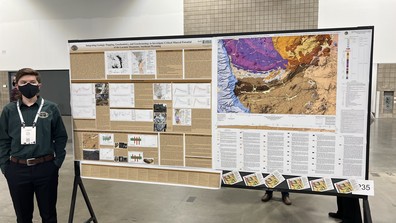|
After a three-year hiatus, the WSGS and University of Wyoming (UW) Geological Museum looked forward to returning to hosting the annual Earth Science Week event in October. Nearly 300 attendees enjoyed this year's event, "Wyoming Rocks: Critical Resources for a Sustainable Future." Activities included planetarium shows, a scavenger hunt, rock identification kits, creative art activity, mineral matching game, and more. Partners this year were the UW School of Energy Resources, Planetarium, and Art Museum.
Caption for top photo: Chelsea Kuhn and 7-year-old Jace picked out rock samples at the WSGS table.
Caption for bottom photo: WSGS hydrologist Jim Stafford discussed minerals in some of our household items with attendees.

In August, WSGS geologists Patty Webber and Kelsey Kehoe spent two days in the South Pass area with Dr. Dean Peterson, chief geologist of Big Rock Exploration. The trip focused on the South Pass greenstone belt, which contains metamorphosed sedimentary and volcanic rocks more than 2.8 billion years old. Dr. Peterson shared his expertise with similar deposits in Canada and Minnesota, which provided a valuable backdrop upon which to understand the local geology.
The South Pass greenstone belt is dominated by metagreywacke and mafic metavolcanics, which have been heavily faulted and folded. Mineralization occurs in these zones of concentrated deformation, known as shear zones, where gold, quartz, and sulfides were deposited.
Historic gold and iron mining at South Pass dates back to the discovery of the Carissa Lode, which spurred Wyoming’s first gold rush in 1867. While large-scale mining hasn’t occurred in the region since the Atlantic City iron mine closed in 1983, Big Rock Exploration is one of a handful of companies actively exploring for gold deposits in this area.
Caption for photo above: A shear zone cuts through greenstone and metagreywacke beds in a roadcut along Wyoming Highway 28.
|
  Several members of the WSGS team attended the October Geological Society of America conference in Denver. Geologist Derek Lichtner, in the top photo, presented his work on rare earth elements in heavy-mineral sandstones in southwest Wyoming. Lichtner authored a report last year about the heavy-mineral sandstone in the Upper Cretaceous Rock Springs Formation at Richards Gap in southwest Wyoming. He’s currently working on a related project that involves heavy-mineral sand deposits of all ages throughout the state.
Geologist Patty Webber presented her work on critical mineral potential of the Laramie Mountains in southeast Wyoming. The results of Webber’s two-year investigation will soon be released as a pair of maps and a report. This project is part of the U.S. Geological Survey’s Earth Mapping Resources Initiative (Earth MRI) program.
|